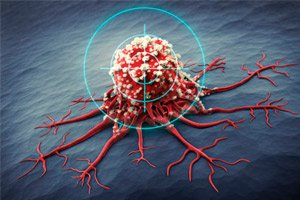
All iLive content is medically reviewed or fact checked to ensure as much factual accuracy as possible.
We have strict sourcing guidelines and only link to reputable media sites, academic research institutions and, whenever possible, medically peer reviewed studies. Note that the numbers in parentheses ([1], [2], etc.) are clickable links to these studies.
If you feel that any of our content is inaccurate, out-of-date, or otherwise questionable, please select it and press Ctrl + Enter.
'Turn off tumor camouflage': Oral HO-1 inhibitor reshapes immune microclimate and enhances chemotherapy
Last reviewed: 18.08.2025
 ">
">Science Translational Medicine describes a new oral inhibitor of the enzyme heme oxygenase-1 (HO-1) — the molecule KCL-HO-1i. It targets a special subset of macrophages near tumor vessels (LYVE-1⁺ perivascular TAM), which maintain a “cold” (immune-suppressed) microclimate and reduce the effect of chemotherapy. By blocking HO-1 in these cells, the researchers “warm up” the tumor: more CD8⁺ T cells enter, and standard “chemotherapy” works better — at least in mouse models of breast cancer and sarcoma. The work was published on August 6, 2025, and is entirely preclinical.
What was invented and why is it important?
- Who are we beating? In the tumor, next to the vessels, there lives a “guardian of order” — LYVE-1⁺ perivascular macrophages. They form “nests” from where they regulate their neighbors and, as it were, “push away” the killer T-cells; the key to their strength is the activity of the enzyme HO-1 (anti-inflammatory, immunosuppressive effect). If this lever is turned off, the defense weakens.
- What is this drug? KCL-HO-1i is an oral small HO-1 inhibitor (next generation porphyrin-based), with claimed bioavailability in mouse models and a half-life of ~3 hours. This is important for HO-1: most classical inhibitors are poorly suited for oral administration.
- What is the effect in models? In “cold” tumors (spontaneous MMTV-PyMT model of breast cancer and MN/MCA1 sarcoma), the combination of KCL-HO-1i + standard chemotherapy provided more stable growth control and “warmed up” the microenvironment — more CD8⁺ T-effector cells entered the tissue.
What happens in a tumor
A tumor is not only cancer cells, but also a micro army of immune and vascular cells. Some macrophages near the vessels put up a “barrier screen” and make the tumor “cold” — the immune system does not see the target, and “chemotherapy” acts weaker.
HO-1 is their “quieter” button. When it is pressed (HO-1 is active), the inflammation is extinguished, T-cells stay away. KCL-HO-1i takes the finger off this button: the “screen” falls, T-cells come in, and it is easier for chemotherapy to finish off tumor cells.
What exactly did you do in the work?
- An oral HO-1 inhibitor, KCL-HO-1i, was designed and characterized; its pharmacokinetics (oral bioavailability in mice) were demonstrated.
- Tested in models of chemoresistant tumors (spontaneous breast cancer MMTV-PyMT, sarcoma MN/MCA1): in combination with “chemotherapy”, the drug enhanced tumor control and increased CD8⁺ T-cell infiltration.
- They tightened up the mechanics: they referred to early data on LYVE-1⁺ perivascular “nests” and their connection with HO-1 and “repulsion” of CD8⁺ cells; now they propose a pharmacological switch for this pathway.
- Formulation and profiling. The supplementary materials describe the technology for obtaining and formulating KCL-HO-1i and testing off-target activity, an important step toward translation.
How is this different from conventional immunotherapy?
This is not another checkpoint inhibitor or CAR-T. It targets a specific niche of macrophages within the tumor to remove the local immune "jammer" and thereby enhance the chemotherapy already being used. This approach fits well into combination regimens.
How close is it to people?
So far this is preclinical (mice, tissues, pharmacology). The author's team emphasizes the platform meaning: an oral tool has appeared that hits HO-1-dependent LYVE-1⁺ PvTAM - it is logical to test it further:
- compatibility with various chemotherapeutic agents and, possibly, with immune checkpoint inhibitors;
- toxicology and off-target risks of HO-1 inhibition (the enzyme is also important outside the tumor);
- patient selection biomarkers (tumor subtypes with a clear excess of LYVE-1⁺/HO-1⁺ macrophages).
Why this might work in “cold” tumors
Such tumors "kick out" T cells and often respond poorly to immunotherapy. If you rebuild the perivascular niche (remove HO-1-dependent suppression), you can make the tumor "hot" - that is, accessible to both "chemotherapy" and T cells. This is one of the most discussed strategies in modern oncoimmunology.
Important Disclaimers
- Not a clinic yet. We're talking about mouse models - transferring to humans is always a surprise.
- Balance of risks. HO-1 is an enzyme with protective functions in normal tissues; careful assessment of the safety of long-term systemic inhibition is needed.
- Not a panacea. LYVE-1⁺ PvTAM is not an important node in all tumors; biomarker stratification will be required.
Conclusion
The researchers showed that orally blocking HO-1 can disarm a specific subset of tumor-promoting macrophages and enhance the effects of chemotherapy in preclinical models. If the approach is confirmed in humans, it could become a useful combination therapy for cold solid tumors where classical immunotherapy has stalled.
